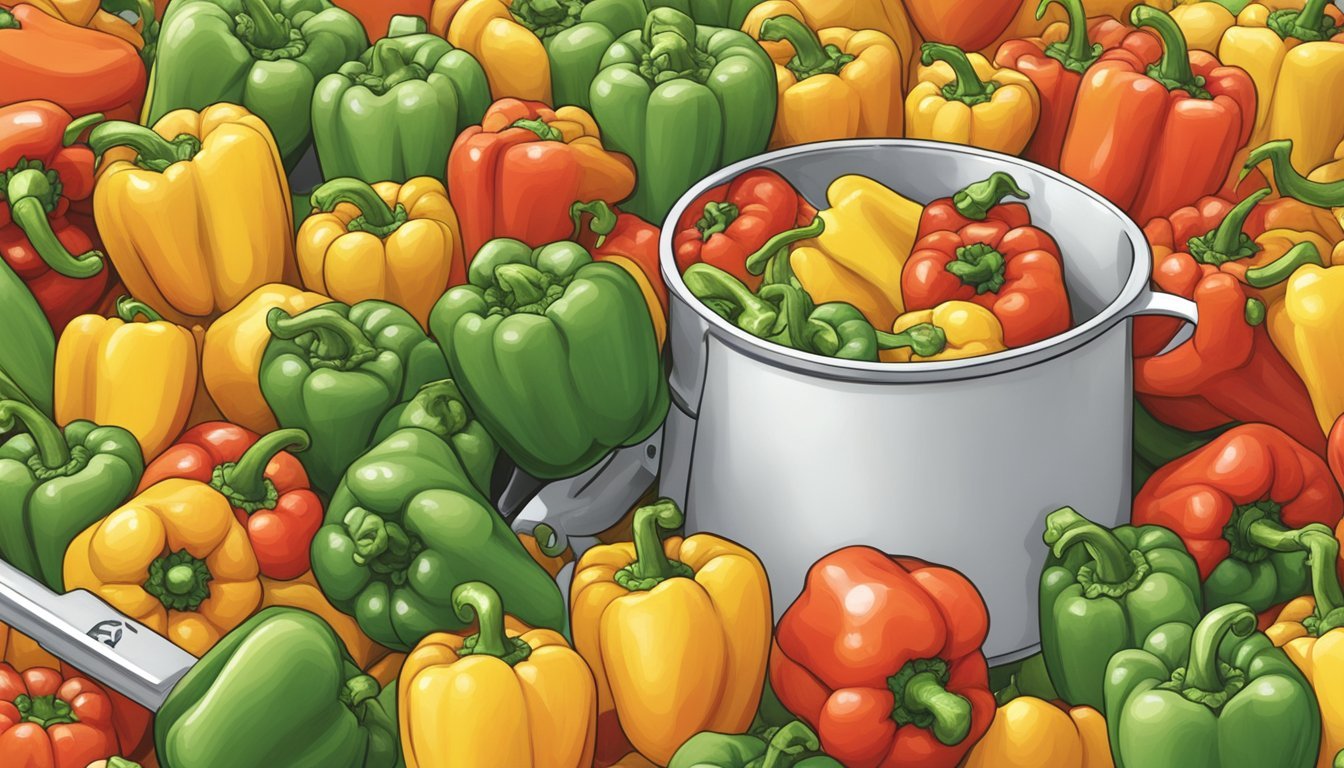How Much Bell Pepper Per Day Is Too Much?
Understanding Daily Limits
Bell peppers (What wine goes well with bell peppers?), vibrant and flavorful, are not only a colorful addition to a variety of dishes but also a powerhouse of nutrition. Rich in vitamins A and C, bell peppers contribute to immune function, skin health, and vision. Their low caloric content and high fiber make them a beneficial component of any diet. The presence of fiber promotes better digestion and contributes to prolonged satiety, which can aid in weight management.
Health experts suggest incorporating a range of vegetables into one's diet, and bell peppers fit well within this spectrum. Typically, consuming 1-2 servings of bell peppers daily is well within the recommended dietary guidelines. This quantity ensures individuals can reap the nutritional benefits without overconsumption.
When determining the appropriate amount of bell peppers to consume, it's essential to consider individual dietary needs and caloric intake. Since bell peppers are low on the glycemic index, adding them to meals can help manage blood sugar levels, making them a suitable option for most dietary plans. As with any food, moderation is key to maintaining balance and ensuring a varied intake of fruits and vegetables for holistic health benefits.
Bell Pepper Basics
Bell peppers, an integral part of the capsicum family, offer a wealth of nutrients and come in a variety of vibrant colors that correspond to diverse flavors. They are enjoyed globally and are as nutritious as they are flavorful.
Definition and Classification
Bell peppers are fruits from the Capsicum annuum species, often classified as vegetables in culinary contexts. Unlike their capsicum relatives, they are sweet and lack the capsaicin that gives hot peppers their heat.
Nutrient Profile
A remarkable source of vitamins, bell peppers provide an abundance of Vitamin C, vital for immune function, Vitamin A, critical for eye health, and Vitamin K, essential for blood clotting. They also contain antioxidants and carotenoids, which combat oxidative stress. Bell peppers are fiber-rich, supporting digestive health. Here's a brief overview of their nutritional value per medium-sized pepper:
Vitamin C: 169% of the Reference Daily Intake (RDI)
Vitamin A: 75% of RDI
Vitamin K: 9% of RDI
Fiber: 2.5 grams
Color Varieties and Flavor
The color of bell peppers can range from green, yellow, and orange to red, each representing a different ripeness stage and flavor profile.
Green: Typically the least sweet, more bitter.
Yellow/Orange: Sweeter than green, with a fruity taste.
Red: Sweetest of all, with a full-flavored richness.
As bell peppers mature, they gain more carotenoids and antioxidants. The varied flavors and colors ensure that bell peppers can cater to a wide array of dishes, adding both nutritional value and culinary appeal.
Health Benefits
Bell peppers are an exceptional source of nutrients that contribute to various health benefits. They contain high levels of vitamin C, antioxidants, and other essential nutrients that support bodily functions and protect against health issues.
Antioxidant Effects
Bell peppers are rich in antioxidants, including vitamin C and various carotenoids, which help protect the body's cells from damage. Red bell peppers, in particular, are known for their high antioxidant content.
Supporting Eye Health
Carotenoids such as beta-carotene and lutein in bell peppers are beneficial for eye health. They can help reduce the risk of eye diseases and support overall eye function.
Immune System Boost
The high level of vitamin C in bell peppers is crucial for the immune system. It helps strengthen the body's natural defenses and promotes skin health, which acts as a barrier against pathogens.
Heart Health
Consuming bell peppers can contribute to heart health. These vegetables have been linked to the reduction of heart issues, predominantly due to their fiber, antioxidant, and vitamin content. Green peppers also offer a variety of B vitamins that support heart function.
Daily Consumption Guidelines
When considering the intake of bell peppers, it is essential to balance nutritional benefit against the possibility of overconsumption. The following subsections will discuss the recommended dietary allowance and potential risks associated with consuming too much.
Recommended Dietary Allowance
The Recommended Dietary Allowance (RDA) for bell peppers has not been explicitly set; however, nutritionists often suggest that 1-2 servings per day are adequate for most individuals. A serving is approximately one cup of chopped bell peppers. These vegetables provide a substantial amount of vitamin C, with one medium-sized red bell pepper offering up to 169% of the daily value, and are also a good source of vitamin A, potassium, vitamin B6, and folate. Additionally, bell peppers are rich in dietary fiber, which supports digestion, and contain various antioxidants that can contribute to overall health.
Potential Risks of Overconsumption
Although rare, consuming an excessive amount of bell peppers can lead to potential health concerns:
Carbs: While bell peppers are low in carbohydrates, overeating can accumulate excess carbs in a low-carb or ketogenic diet.
Allergy: Individuals sensitive to nightshades may experience allergic reactions to bell peppers.
Digestion: Excessive fiber intake may lead to digestive discomfort in some people.
A diverse diet is recommended to ensure a balanced intake of nutrients, so including a variety of vegetables alongside bell peppers is beneficial. It's also advisable for those with specific dietary needs or health conditions to consult a healthcare professional for personalized guidance.
Cooking and Preparation
When considering bell pepper consumption, it's important to understand how cooking methods and meal integration can affect their nutritional value and incorporation into diets.
Raw vs. Cooked Nutrition
Bell peppers can be consumed both raw and cooked, each form offering different nutritional benefits. Raw bell peppers maintain all of their vitamin C content, which is sensitive to heat; therefore, they provide a higher amount of this nutrient compared to cooked peppers. A cup of raw, chopped red bell peppers contains over 3 grams of dietary fiber, approximately 12 percent of the recommended daily value.
In contrast, when cooked, bell peppers' cell walls break down, making them easier to digest for some individuals. However, culinary processes like roasting or sautéing can cause a reduction in some nutrients, such as vitamin C. Yet, cooking can increase the availability of other nutrients, like carotenoids.
Integrating Bell Peppers into Meals
Bell peppers are versatile vegetables that can enhance the flavor profile of various meals. They can be sliced raw into salads for a crisp texture and vibrant color or roasted with olive oil to bring out their sweetness, making them a delicious side dish or a complement to entrees. Here are some specific ways to include bell peppers:
In Salads: Dice or slice bell peppers and add to leafy greens for a nutritious crunch.
As a Snack: Enjoy strips of raw bell peppers with hummus or a yogurt-based dip.
In Cooked Dishes: Bell peppers can be sautéed with onions as a beginning to fajitas or stir-fries.
With Rice: Add chopped bell peppers to rice dishes to boost flavor and nutritional content.
Understanding Nightshades
Nightshades are a diverse group of plants with some members common in diets worldwide. These plants are known for their unique compounds, which can affect different individuals in a variety of ways.
The Nightshade Family
The nightshade family, Solanaceae, encompasses numerous species, many of which are significant food crops. Tomatoes, potatoes (excluding sweet potatoes), eggplants, and peppers of all kinds (including bell peppers, jalapeños, and cayenne) are popular edible nightshades. These plants contain alkaloids, such as solanine, which can be toxic in very high quantities but are typically consumed safely in moderate amounts.
Common Allergens
Among the nightshade plants, certain individuals may experience allergic reactions or increased inflammation after consumption. While allergies to nightshade plants are relatively uncommon, they can manifest with symptoms like hives, itching, or gastrointestinal distress. Tomatoes, in particular, have been identified as a common allergen. Those with sensitivities or autoimmune conditions, such as arthritis, may also be advised to monitor nightshade consumption due to their potential inflammatory properties.
Considerations for Specific Health Conditions
When considering the consumption of bell peppers in the context of specific health conditions, it's important to evaluate their impact on inflammation, heart disease, and diabetes, as the vitamin and mineral content of bell peppers may influence these health issues.
Impact on Inflammation
Bell peppers contain vitamins such as Vitamin C and Vitamin A, which have been shown to possess anti-inflammatory properties. Specifically, the high levels of Vitamin C in bell peppers can support the body's immune response and may combat inflammation. However, excessive consumption, although typically not harmful, is unnecessary as the body can only utilize a certain amount of these vitamins at a time.
Heart Disease and Bell Peppers
For individuals concerned with heart disease, bell peppers are a beneficial addition to their diet due to their fiber content and the presence of antioxidants. Dietary fiber can help manage cholesterol levels, reducing the risk of heart disease. Bell peppers also provide a good amount of vitamin B6 and folate, which can prevent the buildup of a compound known as homocysteine, excessive amounts of which have been linked to heart problems.
Bell Peppers and Diabetes
Persons with diabetes can benefit from the inclusion of bell peppers in their diets as they are low in carbs and have a minimal effect on blood sugar levels. The fiber in bell peppers aids in blood sugar regulation, by slowing down the absorption of sugar into the bloodstream. Furthermore, bell peppers have a low glycemic index, which is a ranking of how much foods raise blood sugar levels after eating. Despite this, diabetics should balance their intake according to their overall carbohydrate management plan.







